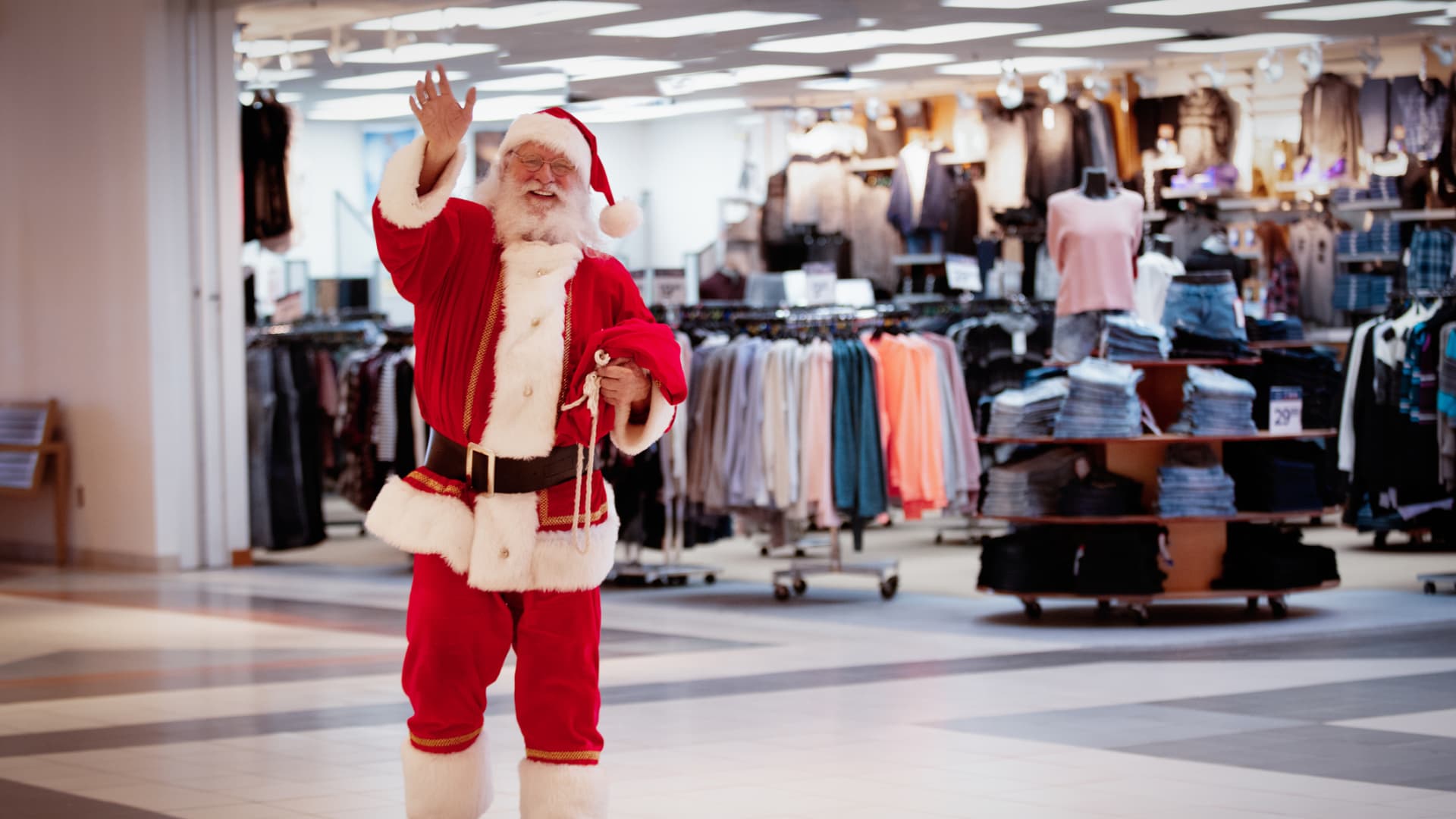Manonallard | E+ | Getty ImagesFor many Americans, it's the first holiday season when most of the family may know the term "artificial intelligence" i
Manonallard | E+ | Getty Images
For many Americans, it’s the first holiday season when most of the family may know the term “artificial intelligence” if it comes up during Christmas dinner.
Just don’t expect AI to do the heavy lifting for Santa quite yet.
The rise of generative AI — and the use of ChatGPT — has inspired more retailers and holiday shoppers to experiment with the technology this holiday season. But for now, most of the technology’s influence will come in ways consumers won’t see.
Artificial intelligence is expected to influence $194 billion in global online holiday spending, according to an estimate by Salesforce. The software company, which tracks shopping trends, said AI influenced $51 billion of online sales during Cyber Week, the seven-day period from Tuesday, Nov. 21, through Monday, Nov. 27, better known as Cyber Monday.
Much of that AI influence, however, comes through features that shoppers already know, such as product recommendations based on past purchases and searches by similar shoppers.
Customers will have to wait for more transformative uses of AI in future holiday seasons, said Rob Garf, Salesforce’s vice president and general manager of retail and consumer goods. Yet he said AI will ultimately change the customer experience.
As retail workers across stores, call centers and offices can automate more tasks, they could have more free time — and patience — for customers, Garf said. And, he said, as AI understands natural language better, retailers can personalize websites and apps to create digital assistants that suggest items, answer questions and more.
“We are still in early days,” he said. “Retailers are testing and learning, and it’s only a leading indicator of what to come.”
Even as companies hype AI’s potential and investors bet heavily on its future, its limits and risks have come to the forefront as more businesses adopt it.
Here are three major ways that AI is showing up this peak shopping season — and how it may preview the future:
A time-saving and efficiency tool
If you were surprised to find a popular toy in stock at your local store, you may have artificial intelligence to thank.
This season, AI is helping retailers in some major ways behind the scenes. Think of those mundane but critical tasks like ordering the right inventory, crafting more relevant marketing emails or writing detailed product descriptions for a website.
At Walmart, artificial intelligence has shaped decisions about holiday inventory by predicting demand for various items at different stores. For example, the tech can help the company identify a best-selling toy or sweater in a particular region and make sure more are shipped to nearby stores, said Srini Venkatesan, executive vice president of U.S. omni platforms and technology at Walmart.
Target, similarly, is using AI to forecast demand at different stores and predict out-of-stock items, so employees can replenish a shelf before it’s empty.
Nordstrom began using AI to come up with the most efficient routes to get online orders to customers’ doors on time and better understand what shoppers are searching for on its website. For instance, it’s trying to better interpret language, so that a customer’s search for “romantic flowy dresses” leads them to items that best match that aesthetic.
Retailers are also zeroing in on how to use AI to improve productivity, which could reduce the number of workers they need or free up employees’ time to take on other customer-facing tasks. The advancements have also sparked fears that companies will cut back their workforces, a concern that CEOs such as Adobe’s Shantanu Narayen and Walmart’s Doug McMillon have challenged.
Walmart in late August launched its own internal spin on ChatGPT called My Assistant, which more than 50,000 corporate employees can use to craft email pitches or construct slide decks, among other tasks. A company spokesperson declined to say how many employees have used the generative AI tool so far, but said Walmart is training teams on it and suggesting use cases for the tool.
This fall, Amazon also debuted new time-saving features for sellers and advertisers. Instead of getting bogged down with product descriptions, third-party sellers can put in just a few words and sentences and let generative AI do the heavy lifting. Advertisers can also lean on a new tool to generate visually appealing images to accompany a product.
Onurdongel | Istock | Getty Images
A personal shopper
One of the biggest game changers that generative AI could bring to shopping is to create a personal assistant that can select the perfect holiday gift, put together an eye-catching outfit or take on other tasks that make life simpler.
That day hasn’t come yet — but there are glimmers of potential.
About 17% of consumers have used ChatGPT or similar AI-powered tools that understand natural language and generate responses for product research and inspiration, according to Salesforce research. About 10% said they would likely use it to help build their holiday shopping lists, its surveys found.
Instead of heading to stores, shoppers can use a growing number of tech tools to see how clothes might look on their body type and skin tone. Google’s Bard, a competitor to the OpenAI- and part-Microsoft owned ChatGPT, introduced a virtual try-on feature this summer. Walmart has a similar tool to see how clothes may look without entering a store.
On Kohl’s website this holiday season, an AI-powered tool called “Storybook Magic” can create a personalized poem and give customized gift suggestions to shoppers. The poem and suggestions are based on information the user shares, such as favorite hobbies or interests of a family member or friend. Customers could also try out the gift generator during a one-day pop-up in New York City’s Bryant Park, a popular tourist attraction with an ice skating rink and Christmas market.
Inside two Simon Property malls — Long Island’s Roosevelt Field Mall and Del Amo Fashion Center in Torrance, California — stumped shoppers can enlist the help of a tablet-carrying worker dressed as an elf with the “HolidAI” tool on weekends from Thanksgiving through Christmas. The elf guides shoppers through questions about the gift recipient’s favorite activities, personality and sense of style, and then gives three recommendations of items available at stores in the mall.
So far this season, though, the personal assistant AI tools have felt more like buzzy marketing plays than transformative changes to the shopping experience. With the bustle at Roosevelt Field, many shoppers walked right by the elves or may have assumed they were helping out with children’s visits to Santa nearby.
Simon Property declined an interview about the tool, after it issued a splashy press release about it early in the holiday season. Kohl’s declined to say how many people used the gift generator, but said in a statement that it wanted to make holiday shopping easier and more enjoyable.

On Walmart’s website, new search and discovery features powered by AI are on their way, Venkatesan said. The retailer is ramping up a feature that simplifies customers’ search for multiple related items, such as allowing them to prepare for a child’s birthday party or a camping trip so they can find what they need with one search and on a single webpage.
It’s also in the early stages of developing a virtual design assistant. Customers could upload a photo of their living room and get suggested decorations, based on their style and budget. When they see a look they like, they can buy the whole collection of items.
“The end goal is we want to be the customer’s concierge,” Venkatesan said.
Google Pixel 8 and Google Pixel 8 Pro phones are displayed during a Google product launch event in New York on October 4, 2023.
Ed Jones | AFP | Getty Images
A high-tech product
AI could drive sales for some retailers — if it inspires customers to buy or upgrade consumer electronics.
Best Buy, for example, has products on shelves this holiday season with AI features. Those include the Google Pixel 8 and Pixel 8 Pro smartphones and Google Chromebook Plus, which allow people to use AI editing to cut background noise out of a video or merge photos into group photos.
Sunglasses brand Ray-Ban is out with its second generation of high-tech glasses with Meta. The glasses, which start at $299, have AI features similar to voice-activated assistants such as Apple’s Siri or Amazon’s Echo. They can answer questions when the user says “Hey Meta” and can translate a street sign into another language.
And Microsoft Copilot, which uses AI to automate writing, editing and more across Microsoft programs such as Outlook, Word and Excel, can be tacked on and used in all Microsoft devices with Windows 11. Many of the tasks, such as summarizing a video-call meeting, boost productivity or save time.
Big-box retailers and warehouse clubs, including Target, Walmart and Costco, sell some of those products, too.
Yet those AI-related items are unlikely to be at the top of many shoppers’ wish lists this holiday season. Consumer electronics sales have hit a lull after many people upgraded devices and decked out home offices during the pandemic. Plus, the category tends to come with a steeper price tag, and people have pulled back on big-ticket items while dealing with higher prices for food, housing and more.
In November, Best Buy cut its full-year forecast, saying it expects comparable sales to decline by between 6% and 7.5%. Yet on a call with reporters, CEO Corie Barry said sales should snap back in the second half of the year with the help of innovation, including generative AI.

www.cnbc.com

COMMENTS